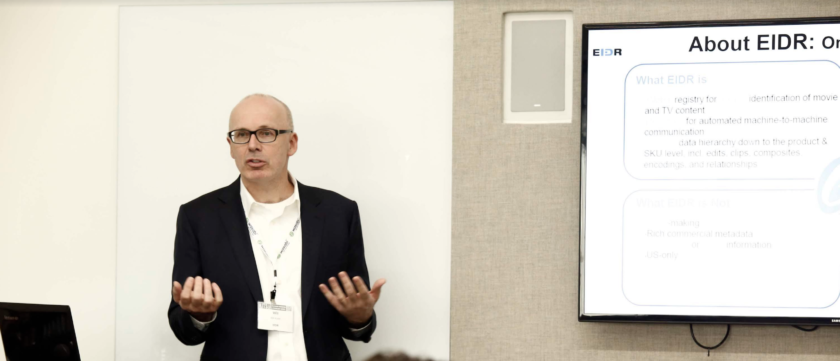LOS ANGELES — Will Kreth, executive director of the Entertainment ID Registry (EIDR), looks at the current, collaborative ID initiatives being undertaken today by the entertainment industry, and finds all sorts of reasons to smile. Because EIDR is right in the middle of all of it.
“Where EIDR stands today is kind of a transition point, a liminal moment … a sense of critical mass,” Kreth said, during an afternoon EIDR workshop presentation Oct. 4 at the Hollywood Innovation & Technology Summit (HITS) Fall event.
Now in its eighth year of existence, EIDR tags for unique pieces of content are nearing 2 million, with nearly 100% adoption among major studio film content, and episodic, TV content quickly catching up. With the explosion of assets and the number of content titles continuing to grow, the benefits — and promise — for the industry having universal, unique IDs is apparent to stakeholders, Kreth said, in that “everyone can rely on a common version of the truth in a non-proprietary way. We can rely on consistency, bringing, eventually, efficiency and speed.”
And a combination of things are boding well for EIDR— and the industry’s goal of better tagging and tracking content — going forward: the Society of Motion Picture and Television Engineers’ (SMPTE) work with the Interoperable Master Format (IMF) standard for broadcast and OTT delivery; the progress with the Entertainment Merchants Association’s (EMA) avails standard; and the Coalition for Innovative Media Measurement’s (CIMM) and SMPTE’s progress with the joint standards initiative, Trackable Asset Cross-Platform Identification (TAXI) Complete, which bind Ad-IDs to commercials and Entertainment ID Registry (EIDR) codes to programming content, using open-source audio watermarking technology.
“We’re trying to create a virtuous cycle here, we’re trying to create a world in which open standards and transparency and the ability to automate everything that is possible to automate … makes it possible for people to do business easily and connect,” Kreth said.
Speaking about TAXI Complete, Harold Geller, executive director of Ad-ID, seconded Kreth’s enthusiasm about the possibilities moving forward, with the standards enabling more accurate tracking and measurement across every platform, and driving cost savings for everyone who buys in.
“When you start to look at this open-standards approach, and you start realizing that the content is what you’re interacting with, these types of open standards work at scale,” Geller said.
Steve Davis, global product director for Kantar Media — which provides the open-source audio watermarking technology for the TAXI Complete standard — said content owners are just beginning to see the benefits of what these new standards can offer.
“When you have this type of technology, there’s an ability to do second screen [synchronization], where what the consumer sees, because of the watermark and because you can detect it, you can automatically interact with the content,” he said.
HITS Fall was sponsored by Amazon Web Services, Box, Microsoft Azure, Ooyala, TiVo, Cognizant, DXC Technology, Gracenote, LiveTiles, ThinkAnalytics, Wasabi, Aspera, EIDR, MicroStrategy, the Trusted Partner Network, human-I-T, Zaszou IT Consulting, OnPrem Solution Partners, and Bob Gold & Associates, and was produced by the Media & Entertainment Services Alliance (MESA), in association with the Content Delivery & Security Association (CDSA), the Hollywood IT Society (HITS), the Smart Content Council and Women in Technology Hollywood (WiTH).
Click here and here to download audio of the EIDR and Ad-ID presentations. Click here for the “EIDR and the International Supply Chain” slide presentation. Click here for the “Setting a New Standard in Cross-Platform Identification: TAXI Complete” presentation.

